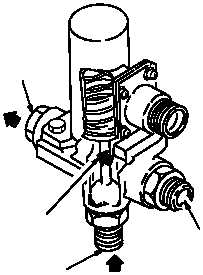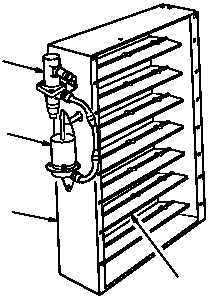TM 1-1520-238-T-4
4–21
4–7
SYSTEM DESCRIPTION (cont)
4–7
(a) Each firewall louver assembly (fig. 4–12) is operated by a louver actuator and a directional control
valve. During operation, the directional control valve closes off pressurized airflow to the louver actuator. The
louver actuator extends by spring tension, pushing the louver vanes open which allows air flow between the main
transmission area and the engine nacelles. If a fire occurs during engine operation, the pilot or CPG FIRE PULL
handle is pulled and the louver vanes close. The louver vanes are closed by pressurized air through the
directional control valve to the louver actuator. Closing the louver vanes keeps air from entering the nacelle and
also keeps the fire fighting agent from entering the main transmission deck.
M58-208A
DIRECTIONAL CONTROL VALVE
LOUVER ACTUATOR
LOUVER ASSEMBLY
DE-ENERGIZED
INLET
VENT
OUTLET
FROM ACTUATOR
AIR VENTING
SHOWN IN
OPEN POSITION
LOUVER
VANES
Figure 4–12.
Firewall Louver Assembly
(b) The cooling louvers are moveable louver type vanes which are located on the cooling louver access
door. When the engine is operating, fifth stage bleed air is directed to the cooling louver actuator (fig. 4–13). Air
pressure against the actuator piston overcomes the spring and extends the piston rod to close the louvers. The
louvers remain closed as long as the engine is operating. When the engine is shutdown, the cooling louvers on
the lower side of the nacelle are opened by the spring–loaded actuator, providing cooling airflow. The fixed
louvers, on the top and bottom aft section of the nacelle, are fixed air scoops that are angled forward, honey comb
filters that prevent foreign objects from entering the nacelle.
(c) The engines are cooled by engine exhaust gases flowing through the primary nozzle (fig. 4–14)
which create a pumping action that draws the surrounding cooling air along with the exhaust gases, this creates a
low–pressure area inside the nacelle that causes cool outside air to flow into the nacelle. Outside air enters the
nacelle through the normally open louver assembly and flows around the engine. Cooling air also enters the
nacelle through the upper and lower fixed louvers and the inlet particle separator transition duct. The pumping
action in the secondary nozzles draws cooling air into the secondary nozzles, where it mixes with and cools the
hot exhaust gases. The cooled exhaust gases exit the secondary nozzles and are immediately dispersed by the
main rotor downwash. Cooling fins on the secondary nozzles help cool the secondary nozzles.



